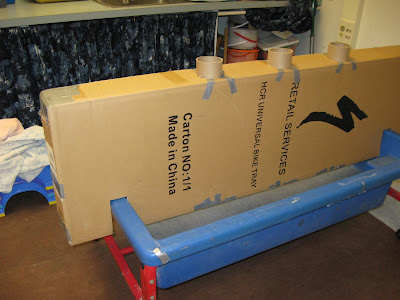I thought it would be too tall to set the long side on the vertical. I considered making it a channel box by setting it on an incline. I eventually decided to use the width of the box and set it up vertically in the middle of the table.
That did two things. First, it divided the table into two separate spaces in which the children could operate.
Second, it allowed me to vertically embed cardboard tubes in the box. That created holes into which the children could pour sand. The sand would disappear, but then come out the bottom.
The box was longer than the table, so I cut notches to hold the box four inches above the bottom of the table because I wanted the sand to come out the bottom of the cardboard tubes and I wanted to create a space underneath the box for the children's play. Besides holding the box above the table, those notches were important for another reason. I was able to use them to securely tape the whole apparatus to the table.


Midweek, I changed the apparatus by adding another box with vertical chutes. I actually embedded it partially over the top of the original apparatus.
The children now had more holes into which they could pour the sand. In the picture below, the child in the yellow shirt poured sand in one of the chutes and watched it come out the bottom. In other words, he had a theory what would happen to the sand when he poured it into the chute; he tested the theory; and he saw the results.
The child also exhibited important motor skills; he poured without looking. So while he tested his theory, he was honing his proprioceptive skills.
I kept this apparatus up for two weeks. The second week I replaced the sand with feed corn to offer a different sensory experience with the same apparatus. Instead of writing about the different sensory experience, though, I want to show how one child used a small space he found to create his own operations.
In axiom #2 on the right hand column of this page, I state that children explore all the spaces in any given apparatus. One child explored a space that was not even on my radar when I built the apparatus. It was the space in-between the chutes on the top of the inserted box.
What could a child possibly do with such a little space? Well, he used a scoop to carefully pile corn into that space.
That was not as straight forward as it looks, though, because he had to look around the top of the chutes so he lost sight of his arm and hand as he completed his actions. As it turned out, this child was also honing his proprioceptive skills.
Once he piled the corn, he used both arms to reach around the chutes and simply feel the corn with his fingers.
Finally, he took a bowl from the table and placed it in that found space. It fit quite nicely. He filled the bowl with corn and again reached around the chutes to bury his fingers in the corn.
I was amazed as I watched this child use this small space as he created his actions and challenges. Why was this space so attractive to the child in the first place? Why did the sequence of his actions and challenges in this small space unfold the way it did? Is there even a why or is there just the doing.
Maybe it is like the building process for me. I may start with an idea that is informed by the shape of the box, but only when I start to physically work on the construction does it become reality. And along the way, I make decisions that affect the final outcome. It is rarely a linear process in which I know what the final construction will look like. The doing is the creating. Given the time, space and materials, this is exactly what the children do all the time.










No comments:
Post a Comment